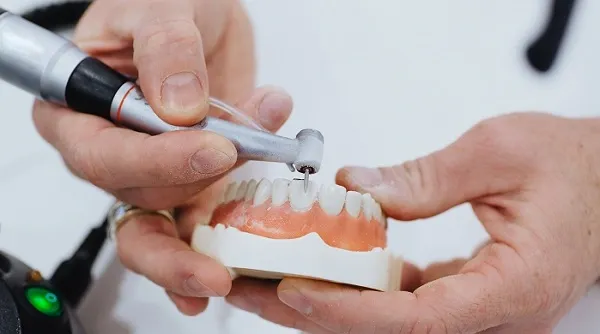Choosing Dental Inlays: Understanding When They're the Ideal Solution
Dental Implants Solutions
In modern dentistry, dental inlays are a versatile and effective way to restore decayed or damaged teeth. This guide delved into the intricacies of dental inlays, shedding light on their purpose, composition, benefits, and procedure for getting them.
What are Dental Inlays?
Dental inlays are custom-made restorations designed to fit precisely within the contours of a tooth's chewing surface. They are typically made from durable materials such as porcelain, composite resin, or gold, offering strength and aesthetics. Unlike dental fillings directly applied to the tooth, inlays are fabricated in a dental laboratory before being bonded into place by a dentist.
Signs and Symptoms Indicating the Need for a Dental Inlay
Recognizing the signs and symptoms that may show the need for a dental inlay is crucial for addressing dental issues promptly. Here are some common indicators that suggest a dental inlay might be necessary:
- Visible Tooth Decay: If you notice visible signs of tooth decay, such as spots or holes in your teeth, it could be a sign that a dental inlay is needed to repair the damage and prevent further deterioration.
- Tooth Sensitivity: Increased sensitivity to hot, cold, sweet, or acidic foods and beverages can indicate underlying tooth decay or enamel erosion, which may require the placement of a dental inlay to restore the tooth's integrity.
- Pain or Discomfort: Persistent tooth pain, mainly when biting or chewing, can signify a cavity or fracture that may necessitate a dental inlay to strengthen the affected tooth and alleviate discomfort.
- Fractured or Damaged Teeth: Teeth that are chipped, cracked, or otherwise damaged may benefit from the reinforcement provided by a dental inlay, helping to prevent further breakage and preserve the tooth's structure.

- Large Fillings: Teeth with large existing fillings may be at risk of further damage or fracture over time. In such cases, a dental inlay can provide additional support and stability to the tooth, reducing the likelihood of complications.
- Worn Tooth Surfaces: Excessive wear and tear on teeth's chewing surfaces can compromise their strength and functionality. A dental inlay can help restore lost tooth structure and protect against further wear, improving the tooth's longevity.
- Previous Dental Work: If you have undergone the last dental treatments, such as root canal or dental crown placement, you may require a dental inlay to repair any remaining damage or strengthen the tooth further.
- Cosmetic Concerns: In some cases, dental inlays may be recommended for cosmetic purposes, such as filling in gaps between teeth or refining the appearance of discolored or misshapen teeth.
If you experience any of these signs or symptoms, it is essential to consult with your dentist promptly to determine the most appropriate course of action.
Advantages of Choosing Dental Inlays
- Conservation of Tooth Structure: One of the primary benefits of dental inlays is their conservative approach to tooth restoration. Unlike dental crowns, which require substantial removal of healthy tooth structure, inlays preserve more of the natural tooth. This conservative preparation helps maintain the strength and integrity of the remaining tooth structure.
- Durable and Long-lasting: Dental inlays are fabricated from high-quality materials such as porcelain, composite resin, or gold, which are known for their durability and longevity. Dental inlays can last many years with reasonable care and maintenance, providing reliable functionality and protection for the restored tooth.
- Customizable Aesthetics: Inlays can be customized to match the color, shape, and contour of the natural teeth, ensuring aesthetically pleasing results. Dentists work closely with dental laboratories to create inlays that blend seamlessly with the surrounding dentition, enhancing the smile's overall appearance.
- Enhanced Strength and Stability: Dental inlays provide excellent reinforcement for teeth weakened due to decay, fractures, or large fillings. Bonding securely to the tooth's surface, inlays restore strength and stability, reducing the risk of further damage or fracture.
- Biocompatibility: Modern dental materials used in the fabrication of inlays are biocompatible and well-tolerated by oral tissues. This minimizes the risk of allergic reactions or adverse effects, making dental inlays a safe and reliable therapeutic option for most patients.
- Minimally Invasive Procedure: Dental inlays placement typically involves minimal discomfort and is a relatively simple procedure compared to other treatments. With advancements in dental technology and techniques, dentists can efficiently prepare, fabricate, and bond inlays, minimizing patient discomfort and chair time.
- Protection Against Decay and Damage: Dental inlays protect against further decay, damage, or wear on the restored tooth. By sealing off the vulnerable areas of the tooth and restoring its natural contours, inlays help prevent bacterial infiltration and reduce the risk of future dental problems.
- Versatility: Dental inlays can restore many dental issues, including cavities, fractures, and extensive tooth damage. Whether it's a posterior or anterior tooth, inlays offer versatility in addressing various dental concerns while preserving aesthetics and function.
The Procedure: What to Expect
The process of receiving a dental inlay typically involves several steps:
- Initial Consultation: Your dentist will check your teeth and discuss your treatment options, including the possibility of dental inlays.
- Tooth Preparation: The affected tooth will be prepared by removing decay and shaping it to accommodate the inlay.
- Impression Taking: An impression or mold of the prepared tooth will be made to ensure an accurate fit for the inlay.
- Temporary Restoration (if needed): Sometimes, a temporary restoration may be placed while the permanent inlay is fabricated in the dental laboratory.
- Placement of the Inlay: Once ready, your dentist will bond it securely to the tooth's surface, ensuring a snug fit and proper alignment.
- Final Adjustments: Any adjustments ensure the inlay feels comfortable and functions appropriately within your bite.

Dental Inlays vs. Other Restorative Options
There are various restorative options available to restore damaged or decayed teeth. Understanding the differences between dental inlays and other alternatives can help patients make informed decisions about their dental care. Here's a comparison of dental inlays with other common restorative options:
1. Dental Inlays vs. Dental Fillings
- Material: Dental fillings are typically made of amalgam (silver fillings) or composite resin (tooth-colored fillings). In contrast, dental inlays are fabricated from porcelain, composite resin, or gold materials.
- Tooth Preparation: Dental fillings require removing a decayed tooth structure and shaping the cavity to accommodate the filling material. In contrast, dental inlays involve more conservative tooth preparation, preserving more natural tooth structure.
- Strength and Durability: Dental inlays are generally more durable and long-lasting than standard dental fillings. They provide better reinforcement for weakened teeth and offer enhanced protection against fracture and wear.
- Aesthetics: While tooth-colored fillings blend reasonably well with natural teeth, dental inlays can be custom-made to match the color, shape, and contour of the surrounding dentition more precisely, providing superior aesthetics.
2. Dental Inlays vs. Dental Onlays
- Extent of Tooth Coverage: Dental inlays are designed to fit within a tooth's cusps (biting surfaces), primarily addressing damage or decay within the central portion of the tooth. Dental onlays, on the other hand, extend over one or more cusps, providing more extensive coverage and support for the tooth.
- Indications: Dental inlays are typically used to restore moderate-sized cavities or damage within the central portion of a tooth. Dental onlays are often recommended for larger cavities or when the damage extends to the cusps or chewing surfaces of the tooth.
- Tooth Preparation: While dental inlays and onlays involve conservative tooth preparation compared to dental crowns, onlays require slightly more tooth reduction to accommodate their larger size and coverage.
- Functionality: Dental onlays may offer greater strength and stability for teeth with more extensive damage or weakened cusps. They provide additional protection against fracture and wear, particularly for posterior teeth subjected to heavy chewing forces.
3. Dental Inlays vs. Dental Crowns
- Extent of Coverage: Dental crowns encase the whole visible portion of a tooth above the gumline, providing comprehensive coverage and protection. In contrast, dental inlays only cover the central portion of the tooth's biting surface, preserving a more natural tooth structure.
- Tooth Preparation: Dental crowns require significant tooth reduction to accommodate the crown's thickness and ensure a proper fit. Dental inlays involve minimal tooth preparation, making them a more conservative option.
- Strength and Durability: While dental crowns and inlays offer durability and reinforcement for weakened teeth, crowns provide excellent coverage and support, making them suitable for more extensive damage or structural compromise.
- Aesthetics: Dental crowns can be fabricated from various materials, including porcelain, ceramic, or metal, offering customizable aesthetics. However, due to their whole coverage nature, achieving a natural appearance may require more extensive preparation and fabrication. Inlays, on the other hand, provide excellent aesthetics while preserving more of the natural tooth structure.
In summary, dental inlays offer a conservative yet effective solution for restoring damaged teeth, providing durability, aesthetics, and functionality. While they may not be suitable for all cases, dental inlays represent a valuable option in the spectrum of restorative dentistry, offering benefits that differentiate them from other alternatives. Consulting with a dentist is crucial for determining the most appropriate therapeutic option based on individual needs and circumstances.
Contact your Walnut Creek dentist, Dr Massood Darvishzadeh, DDS at Dental Implant Solutions, to learn about Choosing Dental Inlays: Understanding When They're the Ideal Solution.
Resource:
*This media/content or any other on this website does not prescribe, recommend, or prevent any treatment or procedure. Therefore, we highly suggest that you get the advice of a qualified dentist or other medical practitioners regarding your specific dental condition*
Subscribe To Our Newsletter
Get Updates And Learn From The Best
More To Explore



CONTACT US
Massood Darvishzadeh, DDS
2021 Mt Diablo Blvd., Suite 100A
Walnut Creek, CA 94596
(925) 939-2600info@dentalimplantsolutions.net